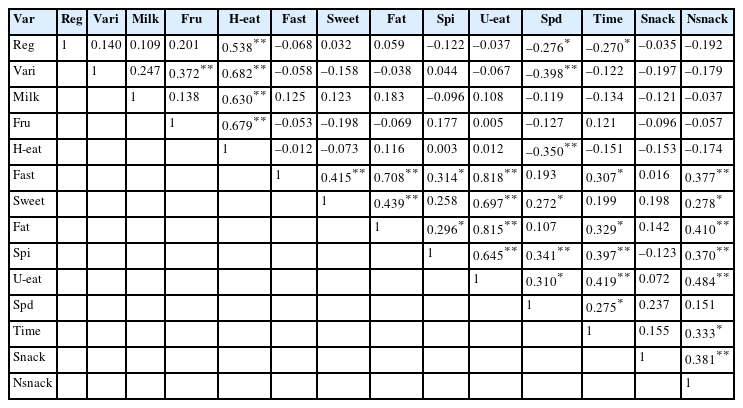Search
- Page Path
- HOME > Search
Research Article
- [English]
- The relationship between smartphone usage and eating behavior for elementary school students in Gangneung, South Korea: cross-sectional study
- Minji Kim, Meera Jang
- Korean J Community Nutr 2024;29(4):278-287. Published online August 31, 2024
- DOI: https://doi.org/10.5720/kjcn.2024.00002

-
 Abstract
Abstract
 PDF
PDF - Objectives
This study investigates the relationship between smartphone usage and eating behavior among elementary school students. Methods: This survey was conducted on 4th- to 6th-grade students at elementary schools in Gangneung from September 6th to September 15th, 2023. Of the 129 copies of the questionnaire that were distributed to 5 schools, 66 copies (51.2%) were returned. Results: Compared to the nationwide statistics, the smartphone ownership rate of elementary school students in Gangneung was lower, but the rate of smartphone overdependence was higher. Smartphone dependence was 21.12 points for study subjects and 26.00 points for the overdependence risk group (Org). Compared to national statistics, the self-control failure factor was higher, so study participants in Gangneung City are thought to have great difficulty with self-control. The Org’s weekend smartphone use time of 7.54 hours was significantly more than the general user group (Gug)’s 4.06 hours. The number of days in which the Org consumed late-night snacks per week was 2.92 days, and the Gug had 2.15 days, but the difference was not significant. Eating fast food showed a positive correlation with eating sweet food, eating fatty food, and eating heavily seasoned food. It was found that frequent consumption of fast food is closely correlated with unhealthy eating behavior. Weekend smartphone use time showed a significant positive correlation with smartphone dependence and the number of days late-night snacks consumed per week. Conclusions: Study participants in Gangneung are more dependent on smartphones than national statistics. Smartphone dependence had a negative correlation with healthy eating behavior and a correlation with average unhealthy eating behavior.
- 3,431 View
- 51 Download

Original Articles
- [English]
- Nutrition Management Examined by Plate Waste Measurement: A Comparison with Elementary Schools and Middle Schools in the Changwon Area
- Hye Kyung Moon, Mi Sun Park, Kyung Hye Lee
- Korean J Community Nutr 2008;13(6):879-889. Published online December 31, 2008
-
 Abstract
Abstract
 PDF
PDF - The purpose of this study was to examine nutrition management conditions of lunch with the elementary schools and middle schools in the Changwon area. 292 students (5th and 6th graders) from three elementary schools and 330 students from three middle schools (boys, girls, and co-ed) participated in the aggregate selective plate waste measurement for 5 days. Planned menus, serving sizes and plate waste amount data were collected. Nutrient analyses for the planned, served and consumed menus at school lunches were performed by using CAN-PRO 3.0. Nutrient analyses of the planned, served and consumed menus were compared with nutrient management standard (former edition) for school lunch and 1/3 Korean Dietary Reference Intakes (KDRIs). Significant difference was found in the average consumption rate between the elementary schools (82.2%) and the middle schools (71.8%). Specifically, the consumption rates of steamed rice (p < 0.001), side dish 1 (p < 0.001), and Kimchi (p < 0.01) at the middle schools were significantly lower than those of the elementary schools. When the nutrient contents in the served menus were put into percentages to the nutrient contents in the planned menus, middle schools (92.3%) showed bigger serving loss than the elementary schools (95.4%). In the nutrient assessment comparied with nutrient management standard (former edition), middle school lunches showed comparatively less energy or less some nutrient contents against the standard than the elementary school lunches. Specifically, in case of boys in middle schools, Vitamin C was the only nutrient content that satisfied the standard in the planned menus, served menus and consumed menus. In the 1/3 KDRIs based assessment, middle schoolers were found not to be provided proper nutrients with school lunches. To improve nutrition management at middle school foodservices, dietitians should reinforce nutrient assessment for menu planning, and try to decrease serving loss and plate waste.
- 382 View
- 1 Download

- [English]
- Adolescents' Nutrient Intake Determined by Plate Waste at School Food Services
- Kyung Eun Lee
- Korean J Community Nutr 2005;10(4):484-492. Published online August 31, 2005
-
 Abstract
Abstract
 PDF
PDF - The purposes of the study were to analyze nutrients of the menus served and to evaluate students' nutrient consumption at school food services. Three middle schools (boys, girls, and co-ed schools) were located in Seoul and Kyunggi Province. A weighed plate method was employed to measure plate wastes and consumption of the menus served. Data was collected for 3 consecutive days at each school. Nutrient analyses for the served and consumed menus were performed using CAN-PRO. On average the students consumed 67% of the menus they were served. By menu category, the students consumed more than 90% of the rice and one-dish foods they were served. Kimchis (54%) and soups/stews (55%) were the menu categories with the lowest consumption rates. The menus served at the boys and coed schools did not meet 1/3 of the recommended daily allowances (RDA) for calcium, iron, and vitamin B2. Due to the plate wastes, the actual consumption of the boys school students did not meet the 1/3 RDA for calories, calcium, iron, vitamin A, vitamin B1, vitamin B2, and niacin. The menus served at the girls school exceeded the 1/3 RDA for all nutrients, but the actual consumption did not meet the 1/3 RDA for calcium, iron, and vitamin B2. During the 3-day periods, the served and consumed menus provided 27% and 24% of energy from fat, which exceeded the recommended proportion of 20%. To improve nutrition management at school food services, dietitians should understand factors that influence students' consumption and implement nutrition education programs that emphasize balanced diets.
- 335 View
- 1 Download


 KSCN
KSCN
 First
First Prev
Prev



